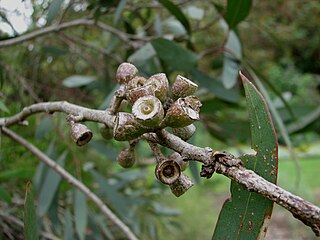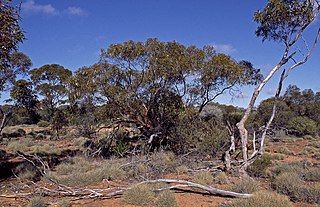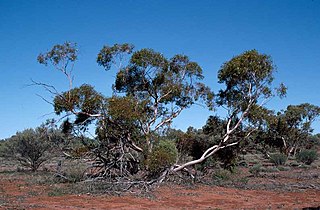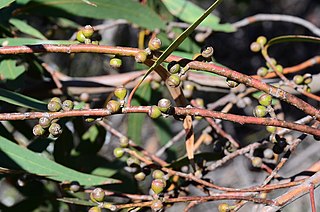
Eucalyptus viridis, commonly known as the green mallee, is a species of mallee or small tree that is endemic to south-eastern, continental Australia. It has rough fibrous or flaky bark on the lower trunk, smooth bark above, linear to narrow lance-shaped adult leaves, flower buds in groups of seven or nine, white flowers and cup-shaped fruit.

Eucalyptus walshii is a small, slender, pole-like tree that is endemic to Victoria, Australia. It has smooth bark, lance-shaped to egg-shaped adult leaves, flower buds in groups of seven to eleven, white flowers and cup-shaped fruit.

Eucalyptus consideniana, commonly known as yertchuk, is a species of plant in the myrtle family and is endemic to south-eastern Australia. It is a tree with rough, fibrous, sometimes prickly bark on the trunk and larger branches, smooth grey bark above, lance-shaped or curved adult leaves, flower buds in groups of between eleven and nineteen, white flowers and conical to hemispherical fruit.

Eucalyptus articulata, also known as the Ponton Creek mallee, is a low, straggly mallee that is endemic to a small area near Kalgoorlie in the Goldfields-Esperance region of Western Australia. It has smooth bark, lance-shaped leaves, flower buds in groups of seven, white flowers and conical fruit.

Eucalyptus wimmerensis, commonly known as the Wimmera mallee box or the broad-leaved green mallee, is a species of mallee that is endemic to an area around the border between Victoria and South Australia. It usually has smooth bark on the trunk and branches, linear to narrow oblong leaves, flower buds in groups of seven to eleven, white flowers and cup-shaped to barrel-shaped fruit.

Eucalyptus concinna, commonly known as the Victoria Desert mallee, is a mallee or small tree that is endemic to Australia. It usually has rough, grey-brown on the lower part of its trunk, smooth bark above, lance-shaped adult leaves, flower buds in groups of between seven and eleven, white flowers and cup-shaped fruit. It has a widespread distribution in South Australia and Western Australia, centred on the Great Victoria Desert.

Eucalyptus arenacea, commonly known as the desert stringybark or sand stringybark, is a tree or a mallee that is endemic to south-eastern Australia. It has rough bark to the thinnest branches, lance-shaped or curved adult leaves, club-shaped flower buds arranged in groups of between seven and fifteen, white flowers and hemispherical to more or less spherical fruit.

Eucalyptus barberi, commonly known as Barber's gum, is a tree or mallee that is endemic to Tasmania. It has mostly smooth, greyish bark, elliptic to lance-shaped or curved adult leaves, diamond-shaped or club-shaped buds in groups of seven in leaf axils, white flowers and cup-shaped, cylindrical or conical fruit.

Eucalyptus corrugata, also known as rough fruited mallee or rib-fruited mallee, is a species of tree or mallee that is endemic to Western Australia. It has rough scaly or fibrous bark on the lower part of its trunk, smooth bark above, glossy, lance-shaped adult leaves, prominently corrugated flower buds arranged in groups of three in leaf axils and ribbed, conical to cup-shaped fruit.

Eucalyptus diversifolia, commonly known as the soap mallee, coastal white mallee, South Australian coastal mallee, or coast gum is a species of mallee that is endemic to an area along the southern coast of Australia. It has smooth bark, lance-shaped adult leaves, flower buds in groups of between seven and eleven, white to creamy yellow flowers and cup-shaped fruit.
Eucalyptus hawkeri is a species of mallee or slender tree that is endemic to Victoria, Australia. It has rough, flaky or fibrous bark on the lower trunk, smooth bark above, lance-shaped or curved adult leaves, flower buds in groups of between seven and eleven, white flowers and cylindrical or barrel-shaped fruit.
Eucalyptus arenicola, commonly known as the Holey Plains peppermint or Gippsland Lakes peppermint, is a tree or mallee that is endemic to south-east coastal areas of Victoria. It has rough, fibrous bark on its trunk and branches, glossy green, lance-shaped adult leaves, club-shaped buds arranged in groups of eleven to twenty five, white flowers and cup-shaped to hemispherical fruit.
Eucalyptus × macmahonii is a species of mallee that is endemic to two small areas in Victoria. It has mostly smooth bark, lance-shaped leaves, flower buds in groups of between seven and eleven, white flowers and cup-shaped to cylindrical fruit.
Eucalyptus ornans, commonly known as Avon peppermint, is a species of mallee that is endemic to a restricted area in Victoria. It has smooth whitish to grey bark, slightly glossy, bluish green, lance-shaped adult leaves, flower buds in groups of between seventeen and twenty one, white flowers and shortened hemispherical fruit.
Eucalyptus phoenix, commonly known as brumby mallee-gum, is a species of mallee that is endemic to a restricted area in Victoria, Australia. It has smooth white to greyish bark, glossy green, lance-shaped adult leaves, flower buds in groups of between five and eleven, white flowers and hemispherical fruit.
Eucalyptus pauciflora subsp. acerina, commonly known as snow gum, is a mallee or small tree that is endemic to a small area of Victoria, Australia. It has smooth, shiny bark, glossy green lance-shaped to egg-shaped leaves, flower buds in groups of between nine and fifteen, white flowers and hemispherical or conical fruit. It differs from other subspecies of E. pauciflora in having a dense crown and no parts that are glaucous.
Eucalyptus pauciflora subsp. hedraia, commonly known as snow gum, is a mallee or small tree that is endemic to a small area of Victoria, Australia. It has smooth bark, branchlets that are often glaucous, glossy green lance-shaped to egg-shaped or elliptical adult leaves, flower buds in groups of between eleven and fifteen, white flowers and hemispherical or cup-shaped fruit. It differs from other subspecies of E. pauciflora in having larger, sessile, glaucous buds and broader, hemispherical fruit.
Eucalyptus pauciflora subsp. parvifructa is a mallee or small tree that is endemic to a small area of Victoria, Australia. It has smooth bark, slightly glaucous branchlets, glossy green, lance-shaped adult leaves, flower buds usually in groups of seven, white flowers and hemispherical or cup-shaped fruit. It differs from other subspecies of E. pauciflora in having a smaller habit and smaller leaves, flower buds and fruit.

Eucalyptus sabulosa, commonly known as Wimmera scentbark, is a species of small, spreading tree that is endemic to Victoria, Australia. It has fibrous or scaly bark on the trunk and branches, lance-shaped to curved adult leaves, flower buds in groups of seven, white flowers and oval to almost spherical fruit.
Eucalyptus silvestris is a species of mallee or small tree that is endemic to Victoria, Australia. It has rough, fibrous or flaky bark on the trunk and larger branches, smooth greyish brown bark above, glossy green, lance-shaped leaves, flower buds usually in groups of seven, white flowers and conical to cup-shaped fruit.











